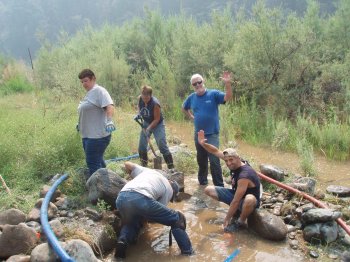
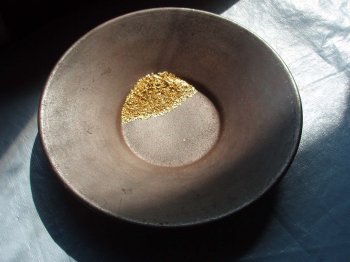
There were 28 members who participated in this group outing. We also had two journalists along for the adventure. One of the journalists, Steve Werblow, is a freelance writer for Homestead Magazine which is an affiliate of the John Deere Magazine. He was writing about the “New Gold Rush” and the people who it has brought out prospecting. We also had a journalist all the way from France named Camille Le Pomellec. Camille was producing a documentary on the The New Gold Rush for a television station in France which is much like our HBO. They, and all of us, were in for a treat when Dave Mack decided to demonstrate the technique of “booming” on this group mining adventure.
As usual, we met at the New 49″er office in Happy Camp on Saturday morning so that all participants had an opportunity to register for the project and pick up any necessary supplies or equipment at the Pro-Mack store. Then we headed over to the Lions Club for Dave”s talk. For those who have never had the opportunity to attend one of these talks, or an outing, I would strongly urge you to fit it into your schedule. The valuable information and hands-on experience you receive will help you immensely in all your pursuits of gold. I”m not just saying this. Having attended all or most of the outings during the past two years, I believe that everyone who participates would agree that the experience is very valuable. Dave schedules five or six of these weekend projects every season. They are free to all New 49″er members. Each person who participates receives an equal share of the gold that is recovered.
Dave”s talk (about how to locate and sample for high-grade gold) ended at around noon on Saturday. The group broke for lunch and then proceeded out to K-15A to do an afternoon of sampling. This consists of panning materials and comparing the results from numerous places along a gravel bar to figure out where the strongest line of gold is ” and at what layer within the gravel the gold is located. By following this simple process, anyone can track down a good location where you can focus productive activity and recover more gold for your effort. Whether you are panning, sluicing, high-banking or suction dredging, a simple sampling program is the key to locating the higher-grade gold deposits.
K-15A has been one of our more popular mining properties this season. I believe this is mainly because Dave has directed multiple group outings along the upper-part of the property, each time with the participants recovering substantial amounts of gold. Members can then go out on their own after the organized project is finished.
A lot of members had been out there since our last project, so we were having trouble making a strike during the first hour or so on Saturday afternoon. While everyone was recovering some amount of gold, we were not getting the results that are needed to make the gold really add up in a high-banker on the following day.
“Hard-pack“ is one of the most important things Dave demonstrates during these group outings. This is compacted streambed which has been deposited by a major flood storm. Since large volumes of gold only move in a waterway during major flood storms, Dave explains that high-grade gold deposits are nearly always located either on top or at the bottom of a hard-packed layer of streambed, or in the contact zone between different layers when more than one is present. This is one of the most important points that Dave stresses during these outings. He is always saying, “You are not even in the game unless you have found some hard-pack!” It”s one thing to read about this in a book. But it is incredibly valuable when you are just getting started to actually be able to see and dig in the right kind of streambed material! Luckily, I had the video camera handy while Dave was showing newcomers this important point:
Because gold is very heavy, it tends to travel down river along concentrated paths during large flood storms. Finding one of these paths is the first step in a sampling program. Since other members had pretty-much mined-out the rich gold deposit which we located during the previous outing, it was time to establish a new one. So Dave called team-leaders, Bruce Waldie, Terry McClure and Richard Krimm together and asked if they knew of any other gold lines along the gravel bar that had previously been established through sampling.
Both Richard and Bruce suggested that we move the sampling-effort down a bit closer to the river, in line with an area where we had done very well last season. Bruce had done some sampling down there earlier this year, and he was saying that the results were pretty good. As Dave explained during his lecture earlier in the day, getting hot tips like this from other members is one of the fastest and easiest ways to locate new high-grade gold deposits. So we gathered up the participants and redirected our sampling efforts to the new area.
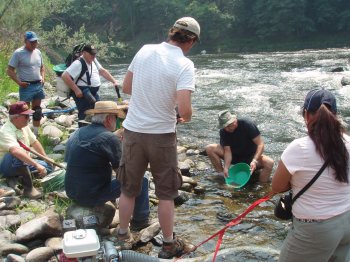 There is another very important thing that Dave demonstrates during these outings. He keeps saying, “Proper sampling is a very exact process.” Since most high-grade gold deposits are located either on top or at the bottom of a compacted flood layer, it is important to be very careful to first clear any sand, loose gravel or other low-grade material from the surface that you want to test. Then, you pass the exact material that you want to test through the proper size of classification screen. This way, you end up with the most concentrated sample that you can fit in your gold pan ” the stuff that is most likely to contain gold if it is present. As Dave explained to the group on this day, preparation of a pan sample in the first place is very likely to make the difference of finding or missing a pay-streak if it is present. Here follows a video sequence showing Dave and some helpers prepare a pan-sample off the top of a layer of some hard-pack:
There is another very important thing that Dave demonstrates during these outings. He keeps saying, “Proper sampling is a very exact process.” Since most high-grade gold deposits are located either on top or at the bottom of a compacted flood layer, it is important to be very careful to first clear any sand, loose gravel or other low-grade material from the surface that you want to test. Then, you pass the exact material that you want to test through the proper size of classification screen. This way, you end up with the most concentrated sample that you can fit in your gold pan ” the stuff that is most likely to contain gold if it is present. As Dave explained to the group on this day, preparation of a pan sample in the first place is very likely to make the difference of finding or missing a pay-streak if it is present. Here follows a video sequence showing Dave and some helpers prepare a pan-sample off the top of a layer of some hard-pack:
Several experienced prospectors were out there helping newcomers dial-in their panning technique, and the very first pans in the new location started showing some really good results. Richard Krimm came up with a pan which was actually the best Dave had seen all season. That”s when I picked up the video camera and started capturing all the excitement. Here follows a video sequence with Dave explaining what was going on:
One of the reasons Dave was so excited is because the terrain within this new location was going to allow us to feed the high-bankers using suction nozzles. This is similar to suction dredging out of the water. But Dave was quick to explain that there is a big difference between dredging and booming. The term “booming” refers to how you use the suction nozzle attachment of the high-banker up on dry land. It actually has nothing
to do with an active waterway. .
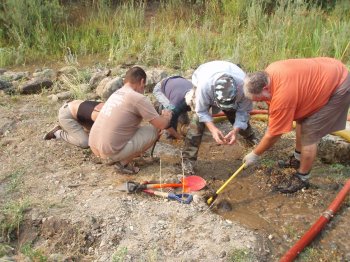 The truth is that it takes quite a lot of effort if you just pick up the suction nozzle outside of a waterway and start sucking material with it. This is because you have to lift the full weight of the nozzle, pressure hose and suction hose ” which are all filled with water. That”s a lot of weight to manipulate around if you want to operate the suction nozzle as we would normally do when dredging under the water.
The truth is that it takes quite a lot of effort if you just pick up the suction nozzle outside of a waterway and start sucking material with it. This is because you have to lift the full weight of the nozzle, pressure hose and suction hose ” which are all filled with water. That”s a lot of weight to manipulate around if you want to operate the suction nozzle as we would normally do when dredging under the water.
In booming, you position your high-banker in such a way that the water which is flowing off the end of your sluice box can be utilized to wash your pay-dirt to your suction nozzle. The nozzle is set in the water (that runs down from your sluice box), while all the pay-dirt is pushed or raked into the flow and is then sucked up by the nozzle and directed to the high-banker”s recovery system. For the most part in booming, the nozzle remains stationary and your effort, along with the water-flow, is used to move the right kind of material to the nozzle.
In essence, you are re-circulating the water which comes off the sluice box. As in normal high-banking, the gold is separated and drops into the various types of matting inside your sluice box. This technique, when done correctly, allows you to process more pay-dirt than you would normally be able to accomplish with a pick, shovel and some buckets. It is wet, dirty, hard work, but sooooo much fun!
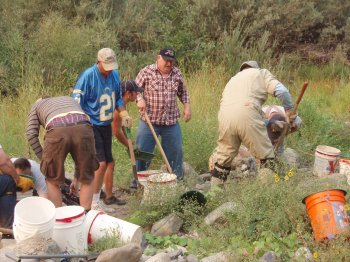
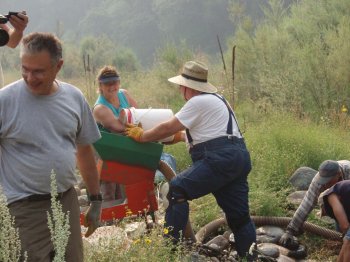
Everyone was anxious to get started on Sunday morning, so the day began at around 7:30 AM. Rich Krimm, one of the team leaders on this outing, had his high-banker in motion and the buckets were already moving steadily when I arrived. Other able bodies were put to work rolling aside rocks from the areas where the booming would occur. If you can remove as many big rocks as possible from your path, it will help you to process much quicker once you begin. Bruce Waldie, Terry McClure, and Ron Beondik assembled the other two high-bankers with their suction nozzles and prepared to begin booming.
Once the areas were cleared, Dave gave everyone direction on exactly what they would be doing, how they were to do it, and where they should start. Since we had established on the previous day that the high-grade pay-dirt consisted mainly of the top one-foot of material, Dave”s main direction to everyone was to not direct material into the high-banker from more than about one foot deep. The high-bankers can only process so much material in several hours, so we want to feed it only with the best material. This would mean that our personal gold-shares would be more valuable at the end of the day. Everybody liked the sound of that!
Soon, the water was flowing, mud was flying, and people were getting down and dirty! I have never seen people working so hard and having so much fun. They could have cared less about getting wet and dirty. It was all about moving as much material as they could towards the nozzle, allowing the water to accomplish a lot of the work. There was a continuous need to move rocks out of the way as they were uncovered; those that were too big to be sucked up the nozzle. Everyone was truly enjoying the day and each other.
Here follows a video sequence with Dave demonstrating what was going on, how a high-banker works, and how to do booming:
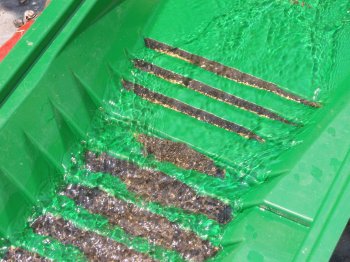 At lunch time, even after over three hours of mud, sweat, lots of water and moving rocks, I could not get anyone to break for lunch. No really; they did not want to get out of the water! Finally, they decided to break in shifts so they could keep the nozzles working. Stops only occurred when the engines ran out of gas, and once when we lost a hose clamp. What a dedicated group of people (or was it just gold fever?).
At lunch time, even after over three hours of mud, sweat, lots of water and moving rocks, I could not get anyone to break for lunch. No really; they did not want to get out of the water! Finally, they decided to break in shifts so they could keep the nozzles working. Stops only occurred when the engines ran out of gas, and once when we lost a hose clamp. What a dedicated group of people (or was it just gold fever?).
When Dave gave the signal to stop you could hear, “Ah please, just 5 minutes more”, “Not yet, we just cleared this area”, “It can”t be time already”, and so on. So Dave gave them their requested 5 minutes and then the motors were shut down. The clean-up from all three of the high-bankers looked really nice as it ran through the Le Trap concentrator. We were seeing some chunky gold and several nuggets.
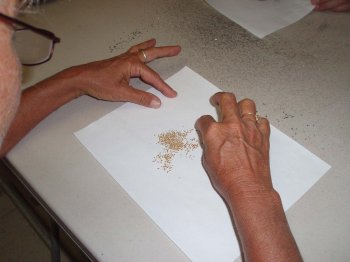 One of the most important things I have learned from these projects is that successful gold mining is not just about hard work. To recover a lot of gold, you have to work hard at locating and processing the right kind of streambed material. Once you locate good pay-dirt through sampling, then you have to focus your work on processing just the high-grade material. Here follows a video sequence with Dave demonstrating this most important point:
One of the most important things I have learned from these projects is that successful gold mining is not just about hard work. To recover a lot of gold, you have to work hard at locating and processing the right kind of streambed material. Once you locate good pay-dirt through sampling, then you have to focus your work on processing just the high-grade material. Here follows a video sequence with Dave demonstrating this most important point:
Everyone pitched in to get all the equipment put away, clean up the area and fill in the holes that we had dug. There were a couple of working faces left open for those who would be returning to continue mining on their own. By “working face,” I mean the part of an excavation which meets up with pay-dirt that has not been worked, yet. Several participants were saying that they planned to return on Monday and pick up where we left off.
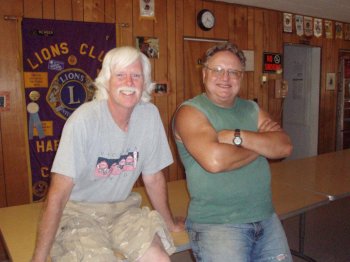 About 30 minutes later, we found ourselves back at the Lions Club in Happy Camp where we were able to complete the final clean-up using a Gold Extractor. This is a specially-designed final clean-up device which eliminates most of the remaining black sand from your gold.
About 30 minutes later, we found ourselves back at the Lions Club in Happy Camp where we were able to complete the final clean-up using a Gold Extractor. This is a specially-designed final clean-up device which eliminates most of the remaining black sand from your gold.
Then, as we were pouring the clean and dried gold through the final clean-up screens, we found that 9 beautiful pieces would not go through the 10-mesh screen. Those folks, are gold nuggets! That was a record for this year and brought on several hoops and hollers, not to mention lots of smiles. All in all, our total gold added up to ¾ of an ounce. Split up amongst 28 participants, everyone received a real nice share of gold for the work we had accomplished together.
“Terry McClure and Bruce Waldie enjoying the moment”
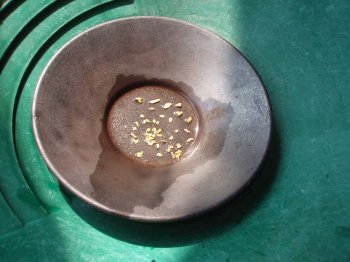 This was my forth outing of this season, and I am so glad that I was able to be a part of it. I have met the greatest people, had a wonderful time, and I am a little sad each time an outing participant says goodbye for awhile. I can only tell you from my experience that if you find yourself with time, please come on out and visit with us, join us on an outing, enjoy the beautiful area around us and take home some fantastic memories. You won”t be sorry you came, and you will leave with more than you came with, in more ways than one. Please contact us to make reservations in advance!
This was my forth outing of this season, and I am so glad that I was able to be a part of it. I have met the greatest people, had a wonderful time, and I am a little sad each time an outing participant says goodbye for awhile. I can only tell you from my experience that if you find yourself with time, please come on out and visit with us, join us on an outing, enjoy the beautiful area around us and take home some fantastic memories. You won”t be sorry you came, and you will leave with more than you came with, in more ways than one. Please contact us to make reservations in advance!
Until the next outing, happy hunting.
- Schedule of Events
- Here is where you can buy a sample of natural gold.
- Here is where you can buy Gold Prospecting Equipment & Supplies.
- More about surface mining
- More about gold dredging
- More about how to prospect for gold
- Books & Videos by Dave McCracken





